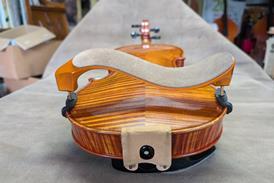All Trade Secrets articles
-
 Premium ❘ Feature
Premium ❘ FeatureTrade Secrets: Using Baker-style mechanics on a double bass
How to fit these brass pegs, gears and tuners, as used by English bass makers in times gone by
-
 Premium ❘ Feature
Premium ❘ FeatureTrade Secrets: Carving a ‘Hill-style’ saddle
Care and accuracy are needed to make a two-piece ebony saddle – in this case for cello
-
 Premium ❘ Feature
Premium ❘ FeatureTrade Secrets: Making a Parisian-eye ring
A step-by-step guide to this intricate part of bow repair
-
 Premium ❘ Feature
Premium ❘ FeatureTrade Secrets: A tool to measure string tension
How luthiers can create a device to find the optimum tension of a string – and a few good reasons to use it
-
 Premium ❘ Feature
Premium ❘ FeatureTrade Secrets: Making purfling
A guide for luthiers who prefer to create their own strips to use in their instruments, rather than buy them ready-made
-
 Premium ❘ Feature
Premium ❘ FeatureTrade Secrets: Making an invisible neck graft
A procedure that takes a little longer than the standard method, but results in an almost undetectable fitting
-
 Premium ❘ Feature
Premium ❘ FeatureTrade Secrets: Decorating a copy of a historical violin
Gold and silver leaf, glass powder and ink are all necessary in this detailed and complex process
-
 Premium ❘ Feature
Premium ❘ FeatureTrade Secrets: Varnish crackle effects
An easy approach to varnish crackle and faux crackle techniques that could be applied to restoration and antiquing
-
 Premium ❘ Feature
Premium ❘ FeatureTrade Secrets: Making a martelé button
A simple method for adding this small detail to your bows
-
 Premium ❘ Feature
Premium ❘ FeatureTrade Secrets: An easy system for making a template and a mould
A method to create classical forms inspired by the work of the Cremonese masters
-
 Premium ❘ Feature
Premium ❘ FeatureTrade Secrets: Making a single-use mould
A method that can be used when making one-off instrument commissions
-
 Premium ❘ Feature
Premium ❘ FeatureTrade Secrets: Gluing the linings with counterforms and springs
An efficient method for a complex process, which allows freedom of movement
-
 Premium ❘ Feature
Premium ❘ FeatureTrade Secrets: Reinforcing a cello bridge
A method of inserting carbon-fibre rods to ensure the bridge retains its shape
-
 Premium ❘ Feature
Premium ❘ FeatureTrade Secrets: Carving the neck on a viola da gamba
One of the last jobs to be tackled in the process of making the Baroque instrument
-
 Premium ❘ Feature
Premium ❘ FeatureTrade Secrets: Making a pigment grinder
A device that removes the effort from the tiresome business of grinding varnish pigments by hand
-
 Premium ❘ Feature
Premium ❘ FeatureTrade Secrets: Making a partial plaster cast
A useful restoration method that can be used when a full cast is unnecessary
-
 Premium ❘ Feature
Premium ❘ FeatureTrade Secrets: Preparing an instrument for varnishing
A guide to the steps needed for the final coat of varnish to show up to its best effect
-
 Premium ❘ Feature
Premium ❘ FeatureTrade Secrets: Removing the mould after gluing the linings
A simple procedure that imitates the methods of the old Cremonese makers
-
 Premium ❘ Feature
Premium ❘ FeatureTrade Secrets: Organic scroll carving
A method for shaping the scroll and pegbox that can give more flowing results, in line with what is seen on old instruments
-
 Premium ❘ Feature
Premium ❘ FeatureTrade Secrets: Making and using a simple collar for self-centring
A useful tool for bow makers, enabling octagonal sections to be accurately centred in a three-jaw lathe chuck






































